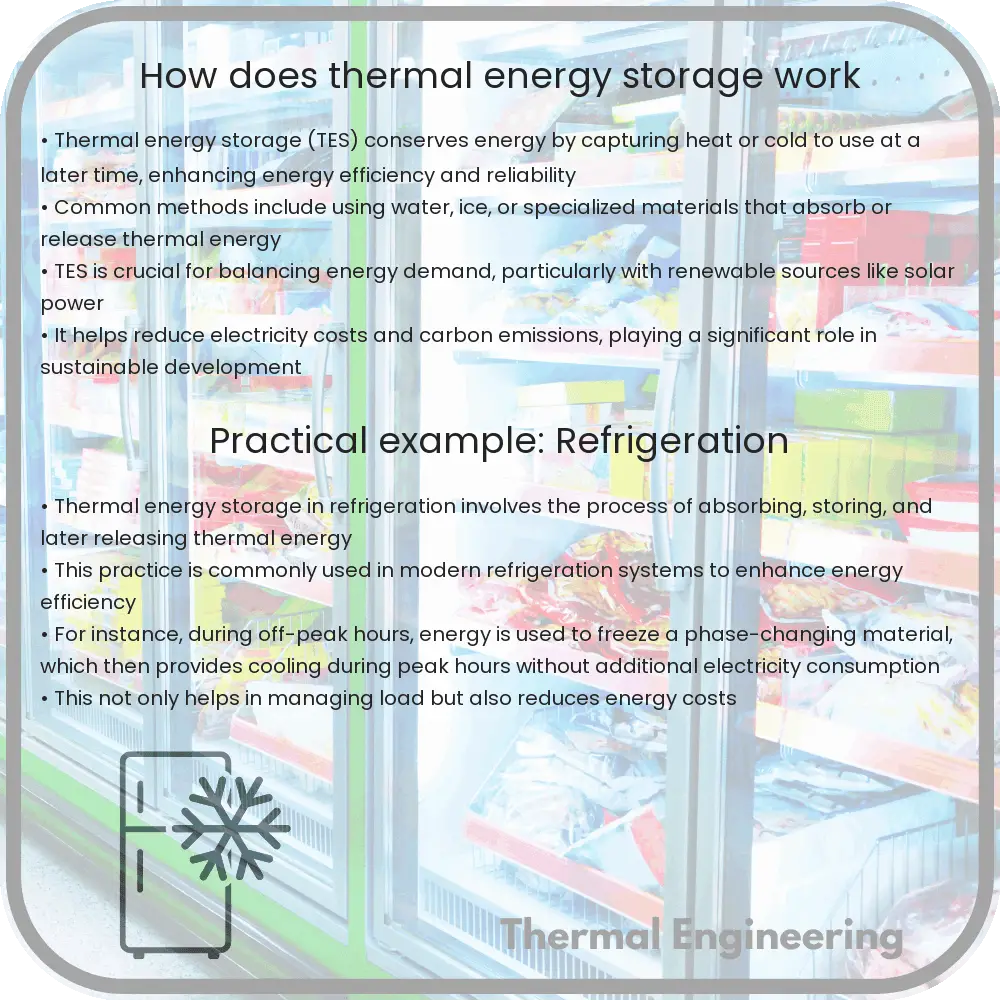Learn about Thermal Energy Storage (TES), a technology that captures and utilizes heat for later use in power generation and climatic control.

Understanding Thermal Energy Storage
Thermal energy storage (TES) is a technology that stocks thermal energy by heating or cooling a storage medium so the stored energy can be used later for heating and cooling applications and power generation. This can lead to substantial operational cost savings and provide an efficient way to manage the supply and demand of energy.
Types of Thermal Energy Storage Systems
Thermal energy storage systems can be primarily classified into three types based on how the energy is stored: sensible heat, latent heat, and thermochemical storage.
- Sensible Heat Storage: This is the most common type of thermal energy storage. It involves storing energy by raising the temperature of a solid or liquid, without a phase change. Common materials used for sensible heat storage include water, sand, and rocks.
- Latent Heat Storage: This approach utilizes the energy change that occurs when a material changes from one phase to another, typically from solid to liquid or vice versa. The energy is stored and released through the material’s phase change at a constant temperature. Materials used for latent heat storage, called phase change materials (PCMs), include paraffin, salts, and certain metallics.
- Thermochemical Storage: The most complex form of TES, thermochemical storage involves chemical reactions to store and release heat. This type of storage allows for higher energy densities and virtually no heat loss over time, though it’s usually more expensive and technically challenging to implement.
How Does Thermal Energy Storage Work?
The basic operation of TES systems can vary significantly depending on the type of storage used, but here’s a general overview:
- Energy Collection: Thermal energy is captured from a heat source. This heat might come from natural sources like solar heat (captured using solar thermal panels), industrial waste heat, or even off-peak electricity converted to heat via an electric heater.
- Energy Storage: The captured heat is transferred to a TES medium. In sensible heat storage, the medium’s temperature increases; in latent heat storage, the medium undergoes a phase change; in thermochemical processes, a chemical reaction occurs to store energy.
- Energy Retrieval: When required, the stored energy is extracted either directly for heating/cooling or converted back into electricity. The retrieval process depends on the inverse processes of storage, such as releasing heat by cooling down the medium or reversing the chemical reaction.
Applications and Benefits of Thermal Energy Storage
Thermal energy storage has a range of applications in both residential and industrial sectors:
- Enhanced Energy Management: TES systems allow for the storage of excess energy during times of low demand and its usage during peak demand periods. This can help in balancing load, thus reducing the need for expensive peak power plants and decreasing energy costs.
- Increased Renewable Energy Usage: By storing surplus energy from renewable sources like solar or wind, TES helps in overcoming the intermittent nature of these resources, allowing for a more stable and continuous energy supply.
- Improved System Efficiency: TES systems can improve the overall efficiency of energy systems by capturing and reusing waste heat that would otherwise be lost.
- Reduced Greenhouse Gas Emissions: By optimizing the energy system and reducing reliance on fossil fuels, TES can significantly lower greenhouse gas emissions.
In conclusion, thermal energy storage is a versatile and powerful tool in the arsenal of energy management and sustainability. Its ability to store excess energy efficiently and to release it on-demand makes it crucial for the future of energy grids worldwide, particularly as we move towards more renewable energy sources and seek greater energy efficiency.